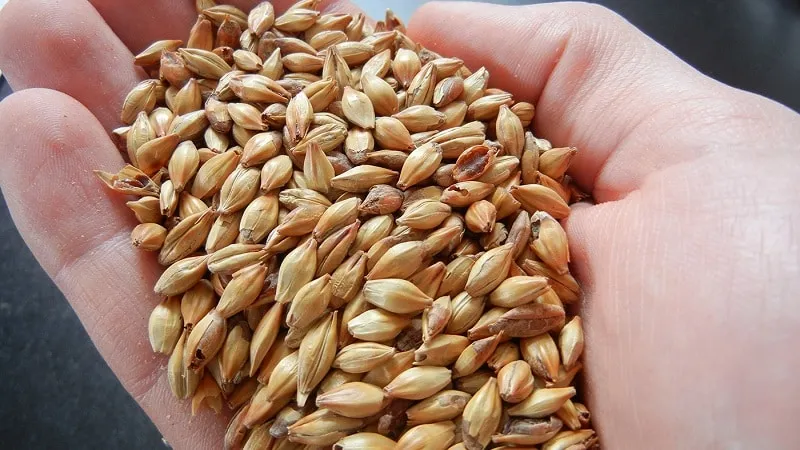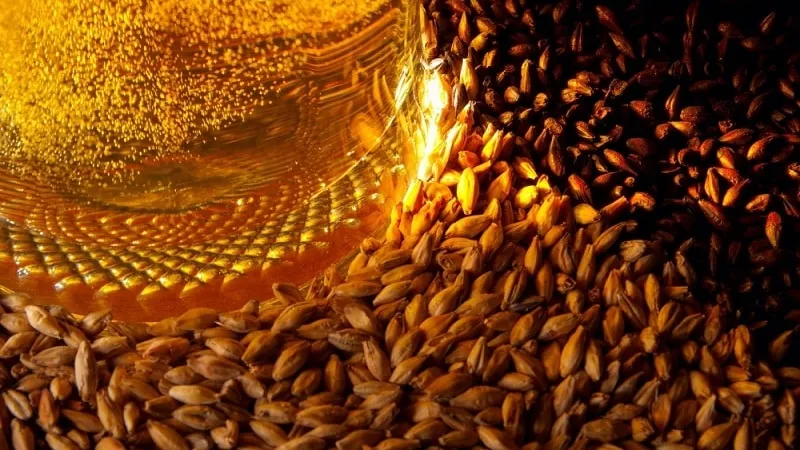The quality of malt determines the taste, aroma, and color of beer. To brew this hoppy beverage, specific barley varieties are used—each one takes breeders an average of 10 years to develop. Special cultivation techniques ensure optimal grain characteristics.
Table of contents
Composition and Biological Features of Brewing Barley
Barley belongs to the grass family (Poaceae). The grain consists of an embryo, starchy endosperm, and husk. Key characteristics of brewing barley:
- High yield, resilience to cold and heat. It grows and develops quickly. The most favorable conditions are stable, gradually rising temperatures without sudden fluctuations.
- Prefers loose, well-aerated soil. Uniform soil composition is crucial. Sandy or loamy soils are unsuitable for most varieties—their high permeability means even short droughts can stunt growth. Clay soil is also problematic, as it restricts root development. Peat bogs and highly acidic soils should be avoided.

Barley grains contain organic and inorganic compounds:
- Carbohydrates. Essential for brewing—they stimulate ethanol production and yeast development.
- Starch (55–66%). Becomes viscous when heated gradually; hydrolysis converts it into sugars.
- Cellulose. Mostly found in the husk, acting as a natural filter during malting.
- Pectic compounds. Enhance beer foam formation.
- Vitamins and minerals. Play a vital role in germination, fermentation, and yeast growth.
Barley also contains polyphenols, fats, organic acids, and ash elements. The key difference in brewing barley is its low protein content (no more than 12%).
Quality Characteristics
Brewing barley varieties have unique malting properties, allowing for efficient processing and higher yields of quality malt.
Key grain traits:
- Shape. Under ideal conditions, grains are oval or elliptical with rounded edges.
- Color. Uniform yellow of varying intensity. A greenish tint indicates immaturity.
- Aroma. Fresh, straw-like scent.
Extract content is crucial—it measures the soluble dry matter after processing. The optimal range is 78–80%.
Barley Classification
Agronomically, barley is divided into winter and spring types. The main difference is sowing time: winter barley is planted from October to November, spring barley from March to April—timing depends on regional climate.
Morphologically, barley is classified as two-row or six-row. Two-row spikes yield 25–30 grains, six-row spikes 30–60. Brewers mostly use two-row varieties.
Barley Varieties for Beer
Hundreds of barley varieties exist. Popular European varieties (yield per hectare):
 Maris Otter. Known for loose spikes, yields up to 6.5 tonnes.
Maris Otter. Known for loose spikes, yields up to 6.5 tonnes.- Golden Promise. A top variety with strong disease resistance and lodging tolerance. Yield: ~9.8 tonnes.
- Puffin. Features loose spikes with large grains. Resistant to lodging and drought. Yield: 4.5 tonnes.
- Laureate. Medium-density spikes with large grains. High disease resistance. Yield: 4–5 tonnes.
- Optic. Yields 4–8.8 tonnes, resistant to root rot and smut. Cylindrical spikes with large grains.
- Concerto. Semi-dwarf variety, yields 3.7–6.5 tonnes.
- Quench. Early-maturing with excellent brewing qualities. Yield: 6–7.8 tonnes.
- Tipple. Cylindrical, loose spikes with large, round grains. Yield: 5–8 tonnes.
Other notable European varieties: Propino, Planet, Sebastian.
Requirements for Brewing Barley
Barley with high protein content (above 12%) is unsuitable for brewing. However, below 9%, beer foam suffers. Other requirements:
- Grains must be large and thin-husked. Average weight of 1,000 grains: 40–45 g.
- No dark spots or ends—these produce poor-quality malt.
- Moisture must be controlled (10–15.5%). Excess humidity causes mold and reduces extract content.
- No weed seeds, other cereals, or pest-damaged grains.
- High germination rate is essential—low rates reduce extract content and promote mold.
Excess fat harms beer flavor and foam stability.
Cultivation Technology
Crop rotation is critical for high yields. Suitable predecessors include buckwheat, maize, and sugar beet. Avoid planting after wheat or legumes.
Key cultivation steps:
- Soil preparation. The seedbed should contain clumps up to 1 cm. Disk harrow (~10 cm) in August, plow (~20 cm) in September. Spring work includes diagonal harrowing and pre-sowing tillage in April.
- Fertilization. Apply phosphorus and potassium in autumn, nitrogen at sowing.
- Seed treatment. Treat seeds with fungicides 2 weeks before sowing. Post-treatment moisture must not exceed 14%.
- Sowing. Begin when soil is physically ripe. Barley germinates at +1°C and tolerates frosts down to -5°C. Seeding rate: 5–6 million seeds/ha. Use continuous row sowing (10–15 cm spacing). Planting depth: 3–4 cm (up to 6 cm in dry soil).
- Weed control. Spring barley competes poorly with weeds—use selective herbicides.
Monitor for pests and diseases, applying insecticides or fungicides as needed.

Harvesting and Storage
Harvest at full maturity, before over-ripening. Check fields 5 days prior—grain moisture should be 18–20%. Signs: drooping spikes in the morning, yellowed straw and husks. Before harvesting, clear field edges and remove lodged areas.
Note! After harvest, clean and dry grains using active ventilation. Next, sort by size.
Storage guidelines:
- Treat storage facilities with pest-control agents.
- Store only cleaned and dried grain.
- Keep temperature below +21°C to prevent weevil infestations. Below +12°C, risks are minimal.
- Store varieties separately to maintain malt quality.
Use silo or floor storage. For silos, max humidity is 13%; for bulk storage, 14%. Higher levels cause heat buildup—ventilate and mix grain if needed.
Conclusion
High-quality barley is the foundation of great beer. Choosing the right variety, following agronomic best practices, and proper storage are essential for producing premium brewing malt.







